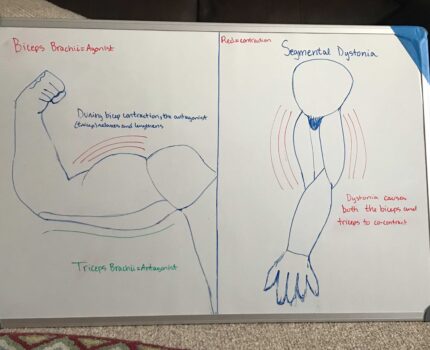A muscle contraction begins with a signal from a neurotransmitter from the nervous system. The signal innervates individual muscle fibers and sodium ions are released, depolarizing the entire fiber membrane and its tubules. Once the membrane has been depolarized, calcium ions are released from storage in the sarcoplasmic reticulum. The calcium ions initiate contraction and is sustained through the use of ATP. As long as the calcium ions in the sarcoplasm remain bound to troponin (when actin-binding sites are “unshielded”); and ATP is available to drive the cross-bridge cycling and the pulling of actin strands by myosin, the muscle fiber will continue to shorten through the contraction.
Normal muscle contraction involves something called reciprocal inhibition, the relaxation of muscles on one side of a joint to accommodate contraction on the other side. Whereas the movement disorder dystonia, is characterized by an abnormal pattern of activity on the electromyogram, with co-contraction of the antagonist’s muscles, and overflows into extraneous muscles. In several studies, a relationship was found between an abnormal suppression of regional cerebral blood flow and a dystonic contraction, meaning when a lack of blood flow to this area is likely to cause a dystonic episode.
My medium is to show a comparison of a normal muscle contraction and a dystonic muscle contraction. The left drawing depicts the normal “wiring” and communication between the motor units and muscles. Myosin heads attach and form cross-bridges, later to let go when ATP is gone. In this isotonic contraction, we can see the agonist muscle is the biceps brachii, and the tricep is the antagonist. The tricep lengthens and relaxes while the biceps sarcomeres continue to shorten. On the right, the dystonic contraction will form cross-bridges as well, only we will have two “agonist muscles”, both the bicep and the tricep; and this co-contracted position will be sustained. Both the bicep and the tricep will be fighting for a contraction but will be stuck in a deformed position.


Dystonia is a movement disorder in which muscles contract involuntary causing twitching movements and repetitive. The disorder can also be caused by drugs like neuroleptics, antiemetics, and antidepressants as these drugs can cause drug induced dystonia reactions. Also alcohol and cocaine also increase the risk of dystonia. Normal muscles contraction is involved in something called reciprocal inhibition. The movement of the disorder dystonia is recognized by its abnormal pattern in the electromyogram. Because of cramps around the muscle movement is painful to others that have it. The process is painful because it may develop into a tremor or other neurological problems that the person will be affected by. The cause of dystonia can be inherited, acquired, or idiopathic. Through several studies a relationship was discovered between abnormal suppressions.
Symptoms included are uncontrolled muscle cramps, and spasms. Dystonia’s are believed to be of result of an abnormality in or a damage to the basal ganglia or other regions of the brain that control the movement of the body. The medium shown to others is a comparison between normal muscles and dystonic muscle contraction. Where it will show myosin heads are attached and form cross bridges later for the ATP when its gone.
The isotonic contraction we can see the agonist muscle near the biceps brachii and the triceps. The triceps help length and relaxes while the biceps sarcomeres as it continues to shorten. The right side the dystonic contraction will form cross bridges as well it also has two agonist muscles.